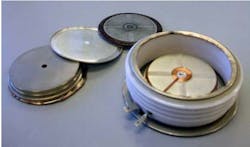Last month, we took a look at the origins of the word thyristor. So now we know where the word came from, but how did the actual device come about? This device changed our industry. It improved HVDC schemes and also brought about FACTS (flexible AC transmission systems). Prior to the thyristor, the mercury-arc valve was the workhorse of HVDC (more on this in a future column). The mercury-arc valve was a finicky piece of equipment that needed a great deal of tender-loving-care. When Bell Laboratories introduced the transistor in 1947, they set the world on the path to solid-state electronics using semiconductor technology. These early transistors were based on Germanium. Electronics became more user friendly because of the transistor’s small size, low power consumption, low heat generation, and high reliability.
This was great for relays, communications equipment, and microprocessors but power electronics needed something more robust. Germanium devices failed at ambient temperatures around 75°C, while power electronics needed to be able to handle much higher temperatures to allow for the high currents and voltages required for power transmission. Research continued on both sides of the Atlantic for a suitable semiconducting material. In 1956, Siemens developed a process for manufacturing high purity monocrystalline silicon for use in transistor applications. A GE engineer visiting the Siemens facility, on an unrelated assignment, saw a sample of the silicon material, which sparked an idea. He must have been very persuasive as he was able to obtain a sample, which he brought back to the United States.
Business Week’s December 1957 issue reported that GE used this material to develop the silicon-controlled rectifier (SCR). The initial SCR had a rating of about 1,000-V, and could handle several hundred amperes of current. GE licensed the SCR technology to other manufacturers and solid-state valve development began. In 1970 ASEA (now ABB) replaced one of the Gotland, Sweden HVDC scheme’s mercury-arc valves with a thyristor valve design. Then, in 1972, GE built the Eel River back-to-back HVDC converter station in New Brunswick, Canada. It was first solid-state HVDC scheme using thyristor valves, which was rated 320-MW at 80-kV. From that point on, the thyristor became the technology of choice for HVDC converter stations. You might say power electronics came about from a lucky accident, but a more accurate description would be an engineer was in the right place at the right time with the right mindset.
About the Author
Gene Wolf
Technical Editor
Gene Wolf has been designing and building substations and other high technology facilities for over 32 years. He received his BSEE from Wichita State University. He received his MSEE from New Mexico State University. He is a registered professional engineer in the states of California and New Mexico. He started his career as a substation engineer for Kansas Gas and Electric, retired as the Principal Engineer of Stations for Public Service Company of New Mexico recently, and founded Lone Wolf Engineering, LLC an engineering consulting company.
Gene is widely recognized as a technical leader in the electric power industry. Gene is a fellow of the IEEE. He is the former Chairman of the IEEE PES T&D Committee. He has held the position of the Chairman of the HVDC & FACTS Subcommittee and membership in many T&D working groups. Gene is also active in renewable energy. He sponsored the formation of the “Integration of Renewable Energy into the Transmission & Distribution Grids” subcommittee and the “Intelligent Grid Transmission and Distribution” subcommittee within the Transmission and Distribution committee.
